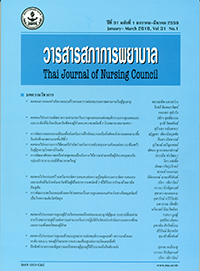ผลของการออกกำลังกายแบบก้าวตามตารางต่อสมรรถภาพทางกาย ในผู้สูงอายุ
Keywords:
การออกกำลังกายแบบก้าวตามตาราง, สมรรถภาพทางกาย, ผู้สูงอายุ, square-stepping exercise, physical fitness, elderly peopleAbstract
บทคัดย่อ: วัตถุประสงค์ของการวิจัย: เพื่อศึกษาผลของการออกกำลังกายแบบก้าวตามตารางต่อสมรรถภาพทางกายในผู้สูงอายุ
การออกแบบวิจัย: การวิจัยเชิงทดลอง แบบสองกลุ่มวัดก่อนและหลังการทดลอง
วิธีดำเนินการวิจัย: กลุ่มตัวอย่างคือ ผู้สูงอายุที่อาศัยอยู่ในตำบลหนองหอย และตำบลท่าศาลา อำเภอเมือง จังหวัดเชียงใหม่ จำนวน 49 ราย โดยการสุ่มแบบหลายขั้นตอนและทำการสุ่มอย่างง่าย เป็นกลุ่มทดลอง 23 ราย และกลุ่มควบคุม 26 ราย ซึ่งกลุ่มทดลองได้รับการออกกำลังกายแบบก้าวตามตาราง นานครั้งละ 55 นาที 3 ครั้งต่อสัปดาห์ อย่างต่อเนื่อง 12 สัปดาห์ โดยผู้วิจัยเป็นผู้นำการออกกำลังกาย ส่วนกลุ่มควบคุมไม่ได้รับการ
ออกกำลังกายแบบก้าวตามตาราง การประเมินสมรรถภาพทางกาย โดยการวัด 2 ตัว แปร คือ 1) ความยืดหยุ่นของกล้ามเนื้อและข้อต่อ โดยวิธีการนั่งโน้มตัวไปข้างหน้า 2) ความทนทานของปอดและหัวใจ โดยประเมินความสามารถในการเดินบนพื้นราบในเวลา 6 นาทีการวิเคราะห์ข้อมูลใช้สถิติทดสอบค่าที
ผลการวิจัย: ความยืดหยุ่นของกล้ามเนื้อและข้อต่อ ความทนทานของปอดและหัวใจของผู้สูงอายุในกลุ่มที่ออกกำลังกายแบบก้าวตามตาราง มากกว่ากลุ่มควบคุมอย่างมีนัยสำคัญทางสถิติที่ระดับ 0.05
ความยืดหยุ่นของกล้ามเนื้อและข้อต่อ ความทนทานของปอดและหัวใจของผู้สูงอายุ
ภายหลังการออกกำลังกายแบบก้าวตามตาราง มากกว่าก่อนการออกกำลังกายแบบก้าวตาม
ตารางอย่างมีนัยสำคัญทางสถิติที่ระดับ 0.05
ข้อเสนอแนะ: การออกกำลังกายแบบก้าวตามตารางสามารถนำไปใช้เป็นแนวทางในการส่งเสริมสมรรถภาพทางกายของผู้สูงอายุได้
Abstract: Objectives: To study possible contribution of square-stepping exercise to elderly people’s physical fitness.
Design: Experimental two-group research with a pre-test and a post-test.
Implementation: This study was conducted on a sample of 49 elderly residents
of Nong Hoy and Tha Sala subdistricts, Mueang district, Chiang Mai province. Selection
of subjects was by means of simple random sampling and multi-stage sampling.
Twenty-three of the participants were placed in the experimental group, and the
remaining 26 in the control group. Only the experimental group members were
required to perform three 55-minute researcher-guided sessions of square-stepping
exercise every week for a total of 12 weeks. The participants’ physical fitness was
measured according to two variables: (1) musculoskeletal flexibility, using a sit-andreach
test; and (2) cardiorespiratory endurance, using a 6-minute walk test (6MWT).
The data were analysed using t-test statistics.
Results: The experimental group displayed significantly greater degrees (0.05)
of musculoskeletal flexibility and cardiorespiratory endurance than did the control
group. Also, after the square-stepping exercise programme, the experimental group
showed significant improvement (0.05) of their musculoskeletal flexibility and
cardiorespiratory endurance.
Recommendations: Square-stepping exercise should be adopted as a means of
promoting physical fitness in elderly people.
Downloads
References
Office of the National Economics and Social
Development Board. Population projections for Thailand.
-2040. [Internet]. 2015[cited 2015, Sept 5].
Available from: http://social.nesdb.go.th /Social Stat
/StatSubDefault_Final.aspx?catid=6 (in Thai)
Miller W. R. Motivational Interviewing in Service
to Health Promotion. Am J Health Promotion 2004;
(3): 1-10.
Schwartz J.B., Zipes D. P..Cardiovascular disease
in the elderly. In: Bonow RO, Mann DL, Zipes DP,
Libby P, eds Braunwald’s Heart Disease: A Textbook
of Cardiovascular Medicine. 9th ed. Philadelphia:
Pa: Saunders; 2011.
Sharma G., Goodwin J. Effect of aging on respiratory
system physiology and immunology. Clin Interv Aging
; 1(3): 253-60.
Jitapankul S. Main principle of Geriatric Medicine.
nd ed. Bangkok: Chulalongkorn University Printing
House;1999. (in Thai)
Elsawy B, Higgins KE. Physical activity guidelines for
older adults. Am Fam Physician 2010; 81(1): 55-9.
Papaioannou A, Morin S, Cheung AM, Atkinson S,
Brown JP, Feldman S, et al. 2010 clinical practice
guidelines for the diagnosis and management of
osteoporosis in Canada: summary. CMAJ 2010;
(17):1864-73.
Institute of Geriatric Medicine. Physical Activity for
elderly and heart disease. Bangkok: Department of
Medical Services, Ministry of Public Health; 2006.
(in Thai)
Shigematsu R, Okura T, Nakagaichi M. Square-
Stepping Exercise Instructor training text. 4th ed. Nagoya:
Institute for Square-Stepping Exercise; 2012.
Shigematsu R, Okura T., Nakagaichi M., Tanaka K.,
Sakai T., Kitazumi S., et al. Square-Stepping Exercise
and Fall Risk Factors in Older Adults : A Single-Blind,
Randomized Controlled Trial. Gerontology A Biol
Sci Med Sci 2008; 63(1): 76-82.
Shigematsu R., Okura T., Sakai T., & Rantanen, T.
Square-stepping exercise versus strength and balance
training for fall risk factors. Aging Clin Exp Res
; 20(1): 19-24.
American College of Sports Medicine [ACSM].
ACSM’s health-related physical fitness assessment
manual. 3rd ed. Philadelphia: Lippincott Williams &
Wilkins; 2010.
Norwood SL. Research strategies. 1st ed. New Jersy:
Prentice-Hall; 2000.
Burns N, Grove SK. The practice of nursing research:
appraisal, synthesis, and generation of evidence.
th ed. St Louis: Mosby; 2009.
Rattanasiri S. Effect of fawn jerng mor chor exercise
on physical fitness among elders. [Thesis].
Chiang Mai: Chiang Mai University; 2008. (in Thai)
Leelarungrayab D, Wongmeekiat O. Physiology of
exercise and Physical Activity for COPD (chronic
obstructive pulmonary disease).In: Leelarungrayab
D, Editor.Clinical Chest Physiotherapy. M.P.T.:
Page 254-81. (in Thai)
American College of Sports Medicine. Quantity and
quality of exercise for developing and maintaining
cardiorespiratory, musculoskeletal, and neuromotor
fitness in apparently healthy adults: guidance for
prescribing exercise. Med Sci Sports Exerc 2011;
(7):1334-59.
Pollock ML, Franklin BA, Balady GJ, Chaitman
BL, Fleg JL, Fletcher B, et al. AHA Science Advisory.
Resistance exercise in individuals with and without
cardiovascular disease: benefits, rationale, safety,
and prescription: An advisory from the Committee
on Exercise, Rehabilitation, and Prevention, Council
on Clinical Cardiology, American Heart Association;
Position paper endorsed by the American College of
Sports Medicine. Circulation 2000; 101(7):828-33.
Silamad S. The sports training for athletic trainers.
th ed. Bangkok: Chulalongkorn University Printing
House;2012. (in Thai)
Weerapong P. Basic principles for therapeutic exercise.
Samutprakarn: Huachiew Chalermprakiet University
Printing House;2011. (in Thai)
Shigematsu R, Okura T. A novel exercise for improving
lower-extremity functional fitness in the elderly.
Aging Clin Exp Res 2006; 18(3): 242-8.
Woo J, Hong A, Lau E, & Lynn H. A randomised
controlled trial of Tai Chi and resistance exercise
on bone health, muscle strength and balance in
community-living elderly people. Age and ageing
; 36(3): 262-268.
Nelson ME, Rejeski WJ, Blair SN, Duncan PW,
Judge JO, King AC, et al. Physical activity and
public health in older adults: recommendation from
the American College of Sports Medicine and the
American Heart Association. Med Sci Sports Exerc
; 39(8):1435-45.
Bourgeois MC, Zadai CC. Impaired Ventilation and
Respiration in the Older Adult. In: Guccione AA,
editor. Geriatric Physical Therapy. 2nd ed. St. Louis:
Mosby; 2000. p. 226-44.
Sobong N. Effect of fawn jerng mor chor exercise
on functional capacity among elders with coronary
artery disease.[Thesis]. Chiang Mai: Chiang Mai
University; 2008. (in Thai)
Jahnke R, Larkey L, Rogers C, Etnier J, & Lin F. A
comprehensive review of health benefits of qigong
and tai chi. Am J Health Promotion 2010; 24(6):
e1-e25.








